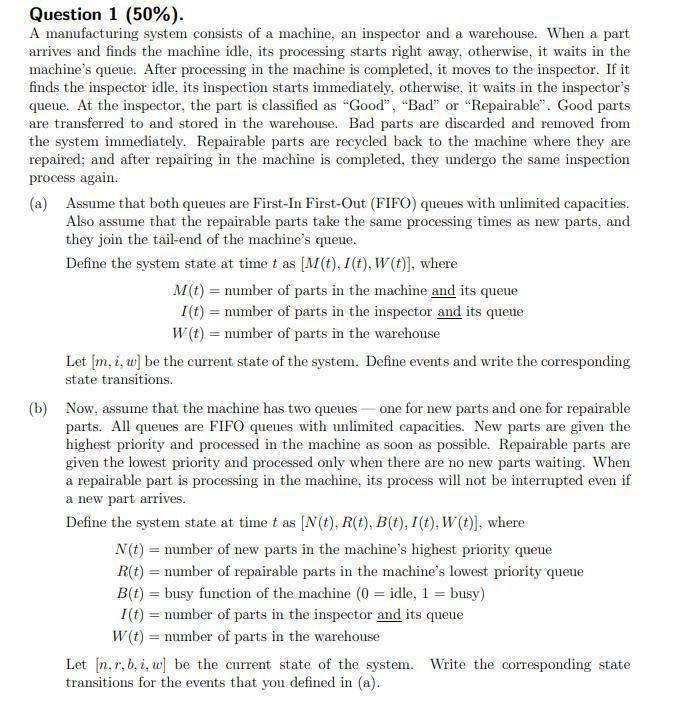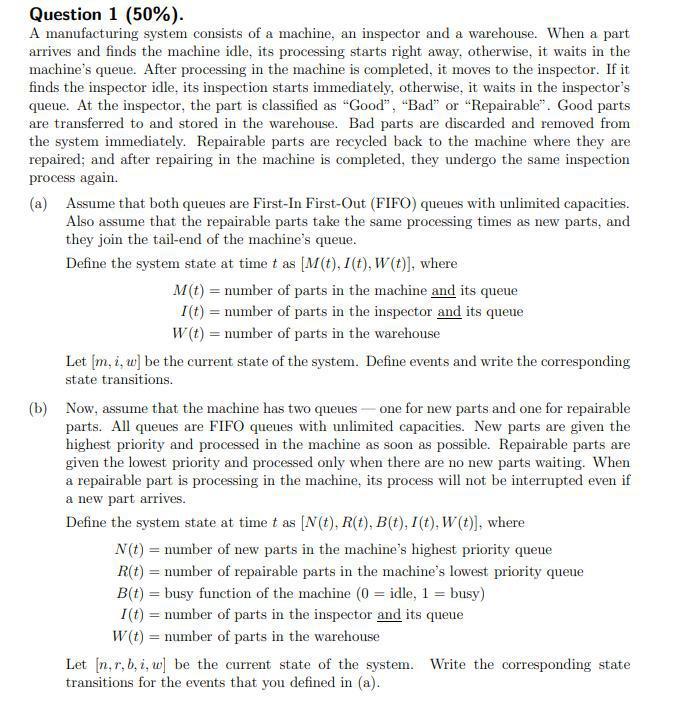
 No any update data, just use the unknown to do, like part arrival [m,i,w]-> [m+1, i,w] thank you!
No any update data, just use the unknown to do, like part arrival [m,i,w]-> [m+1, i,w] thank you!
Question 1 (50\%). A manufacturing system consists of a machine, an inspector and a warehouse. When a part arrives and finds the machine idle, its processing starts right away, otherwise, it waits in the machine's queue. After processing in the machine is completed, it moves to the inspector. If it finds the inspector idle, its inspection starts immediately, otherwise, it waits in the inspector's queue. At the inspector, the part is classified as "Good", "Bad" or "Repairable". Good parts are transferred to and stored in the warehouse. Bad parts are discarded and removed from the system immediately. Repairable parts are recycled back to the machine where they are repaired; and after repairing in the machine is completed, they undergo the same inspection process again. (a) Assume that both queues are First-In First-Out (FIFO) queues with unlimited capacities. Also assume that the repairable parts take the same processing times as new parts, and they join the tail-end of the machine's queue. Define the system state at time t as [M(t),I(t),W(t)], where Let [m,i,w] be the current state of the system. Define events and write the corresponding state transitions. (b) Now, assume that the machine has two queues - one for new parts and one for repairable parts. All queues are FIFO queues with unlimited capacities. New parts are given the highest priority and processed in the machine as soon as possible. Repairable parts are given the lowest priority and processed only when there are no new parts waiting. When a repairable part is processing in the machine, its process will not be interrupted even if a new part arrives. Define the system state at time t as [N(t),R(t),B(t),I(t),W(t)], where N(t)= number of new parts in the machine's highest priority queue R(t)= number of repairable parts in the machine's lowest priority queue B(t)= busy function of the machine (0= idle, 1= busy ) I(t)= number of parts in the inspector and its queue W(t)= number of parts in the warehouse Let [n,r,b,i,w] be the current state of the system. Write the corresponding state transitions for the events that you defined in (a). Question 1 (50\%). A manufacturing system consists of a machine, an inspector and a warehouse. When a part arrives and finds the machine idle, its processing starts right away, otherwise, it waits in the machine's queue. After processing in the machine is completed, it moves to the inspector. If it finds the inspector idle, its inspection starts immediately, otherwise, it waits in the inspector's queue. At the inspector, the part is classified as "Good", "Bad" or "Repairable". Good parts are transferred to and stored in the warehouse. Bad parts are discarded and removed from the system immediately. Repairable parts are recycled back to the machine where they are repaired; and after repairing in the machine is completed, they undergo the same inspection process again. (a) Assume that both queues are First-In First-Out (FIFO) queues with unlimited capacities. Also assume that the repairable parts take the same processing times as new parts, and they join the tail-end of the machine's queue. Define the system state at time t as [M(t),I(t),W(t)], where Let [m,i,w] be the current state of the system. Define events and write the corresponding state transitions. (b) Now, assume that the machine has two queues - one for new parts and one for repairable parts. All queues are FIFO queues with unlimited capacities. New parts are given the highest priority and processed in the machine as soon as possible. Repairable parts are given the lowest priority and processed only when there are no new parts waiting. When a repairable part is processing in the machine, its process will not be interrupted even if a new part arrives. Define the system state at time t as [N(t),R(t),B(t),I(t),W(t)], where N(t)= number of new parts in the machine's highest priority queue R(t)= number of repairable parts in the machine's lowest priority queue B(t)= busy function of the machine (0= idle, 1= busy ) I(t)= number of parts in the inspector and its queue W(t)= number of parts in the warehouse Let [n,r,b,i,w] be the current state of the system. Write the corresponding state transitions for the events that you defined in (a)

 No any update data, just use the unknown to do, like part arrival [m,i,w]-> [m+1, i,w] thank you!
No any update data, just use the unknown to do, like part arrival [m,i,w]-> [m+1, i,w] thank you!





